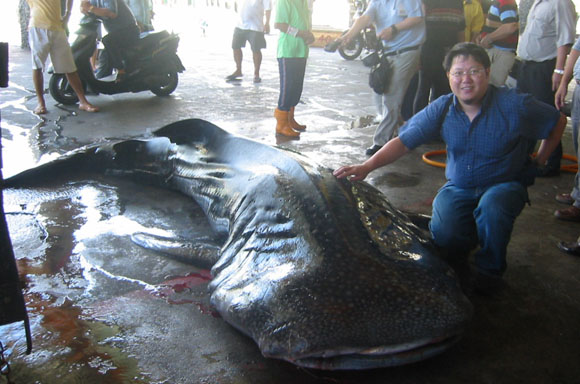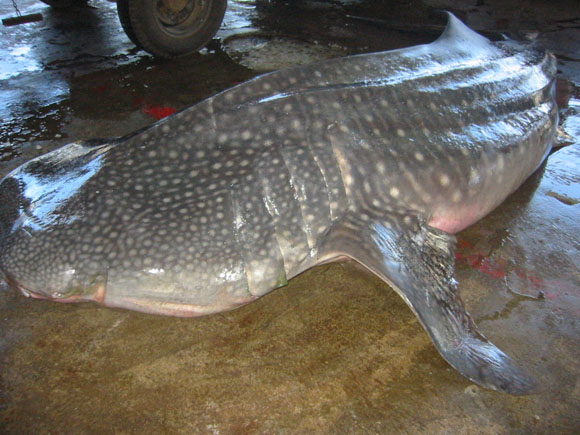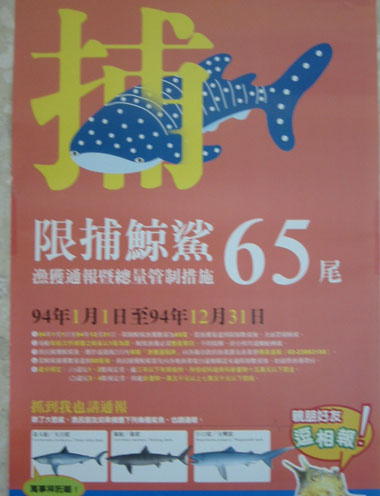
 |
Vertebrates (pdf)
|
Enormous fishing pressure on the whale sharks Rhincodon typus in Taiwan and southern China waters |
|
|
First sighting of the pearlscale butterflyfish in eastern Hong Kong waters |
|
Enormous fishing pressure on the whale sharks Rhincodon typus in Taiwan and southern China waters (pdf)
by Kenny Leung
On November 15, 2002, the whale shark Rhincodon typus was placed on Appendix II of CITES (Convention on International Trade in Endangered Species), a United Nations Treaty Organization which requires the member nations of CITES to monitor international trade in whale shark products and to ensure that international trade does not threaten survival of the species [1]. In many countries such as Australia, India, the Maldive Islands, the Philippines, South Africa and United States, whale sharks are protected, and all trade in whale shark products (fins, flesh and skin) is prohibited [1].
Unfortunately, the flesh of R. typus is considered a delicacy by many people in China, Taiwan, Singapore, Korea and Japan, leading to overexploration in SE Asia. The whale shark is also known as the "tofu" shark in Taiwan (or the white meat whale in Hong Kong), because of its soft white flesh, and it is now the most expensive of the shark meats available on the market. A set of four dried fins runs US $400-500 in Taiwanese markets while the resale value of frozen whale shark flesh for export to Asian markets has reached over US $1/kg [2]. It is therefore not surprising that significant fisheries for whale sharks have been developed in Taiwan and southern China.
 |
|
Fig. 1. A young male whale shark Rhincodon typus . |
In early July 2005, I attended a training workshop on modern fisheries, aquaculture and seafood processing in Taiwan which was organised by the Joint Committee of Hong Kong Fisher’s Association and the Agriculture, Fisheries and Conservation Department of Hong Kong SAR. During the workshop, we visited several major fishing ports in Taiwan and, sadly, encountered two young males of R. typus (3-4 m in length) (Figs. 1 & 2). Lengths of newborn whale sharks range from 0.55 to 0.65 m while the adult can reach as long as 18 m [1]. Through interviews with fishermen, it was estimated that each shark was worth over HK$ 150,000 (or US $19,230).
 |
|
Fig. 2. Young male whale shark (Photo: Kenny Leung). |
As a member of CITES, the Taiwanese Government has made some efforts to control the fishing pressure on the whale shark. Recently, they have implemented legislation to restrict the allowable number of R. typus being caught each year (Fig. 3) Taiwan’s year 94 = 2005]. The restricted quota is 65 whale sharks per year. If the quota is reached within a year (e.g. 1 Jan-31 Dec 2005), a complete prohibition of fishing R. typus will be applied and enforced in the remaining period of that year. To achieve such a goal, all fishermen must report their catch of whale sharks within 2 days after arrival at the fishing port and must bring the whole fish to land. The fishermen are also required to report to the Government if they have caught the basking shark Cetorhinus maximus, megamouth shark Megachasma pelagios and great white shark Carcharodon carcharias. When the quota of R. typus reaches 50, all fishermen should check with the fisheries communication centre to confirm whether there is still quota available before catching more whale shark. Violating these rules will lead to prosecution; the maximum penalties include a maximum of 3 years in jail and a fine of up to NT $150,000 (= HK $34,567 or US $4,455). Obviously, the fine is too small when compared with the market price of a whale shark. The two 'little' sharks I met in Taiwan already made up the quota to 52 in July this year and the market value of each of them is four times more than the maximum fine! As a matter of fact, no one can stop a Taiwanese fisherman from storing or selling sharks in other countries once the quota is filled.
Even worse, when I talked to some Hong Kong fishermen, they told me that there is a big business for catching whale sharks in the South China Sea; especially during late spring and early summer. As the sharks usually migrate along a similar route each year, experienced fishermen are able to locate them relatively easily. The whale sharks are often very friendly and many of them won’t feel threatened when the fishing vessel approaches them. It was not unusual for a team of ten fishing vessels to catch more than ten whale sharks in a day during the peak season near Hoi Nan island. The fishermen all agree that they are easy to catch but very difficult to handle because of their enormous size. One of the fishermen said that he had recently caught one 6-7 m long whale shark and sold it for HK $140,000. Such profit is equivalent to several months of hard work fishing finfish. Undoubtedly there is a huge temptation for fishermen to catch more and more whale sharks. Based on what I heard from the fishermen, there is virtually no monitoring of the number of R. typus being caught in China.
Most shark species breed very slowly; some take more than 20 years to reach sexual maturity, and then have only 2 pups every other year [1]. The current rate of removal of whale sharks is alarming. If such an over exploration trend carries on, R. typus soon will be listed as an endangered species.
What can we do to protect the vulnerable whale shark? First, we should not eat them. If everyone resists consuming them, there will be no demand for them. But it is extremely difficult to educate and change peoples’ minds especially in SE Asia. Secondly, we can help fishermen to establish an eco-tourism business for watching whale sharks, or diving with them instead of killing them. Such eco-tourism has been proved to be sustainable and profitable in many places [1]. Something that you may not know, we can in fact also dive with whale sharks in waters nearby Hong Kong. Last Sunday, I watched a TV documentary made by TVB; it featured the underwater treasures in Hong Kong. In eastern waters, two professional divers found and filmed a young whale shark (5-6 m long) near a place called "Tai Ching Jum" and they certainly enjoyed swimming with this lovely creature. I would like to propose that SWIMS organize a trip for us to dive with our 'local' whale shark. Perhaps, we should also carry out some insightful scientific studies with a view to learning more about this magnificent fish.
 |
|
Fig. 3. Information on protective legislation (Photo: Kenny Leung) |
Bibliography
| P.4-5 |
|
Porcupine! |
 Copyright © 2000 |
